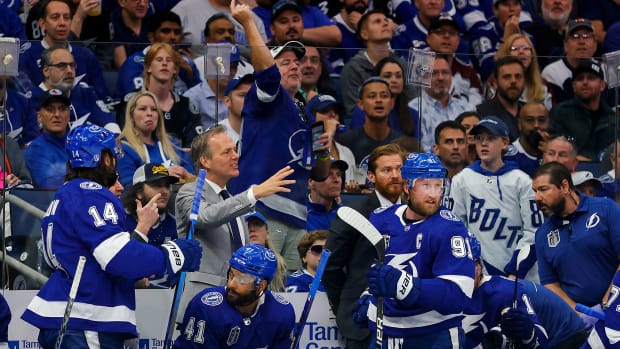TAMPA – If you caught Game 3 in Tampa Bay, one of the highlights — or, maybe, lowlights? — of the game was a lengthy video review process that ultimately took away what would have been a 1-0 goal for the Colorado Avalanche.
It started off first with Lightning coach Jon Cooper taking a while to get a good look over video replay, and ended with the Toronto-based situation room taking their time to call the goal off.
In the end, it didn’t count, but the Avalanche still managed to take a 1-0 lead shortly after. It didn’t last for long, and the Bolts skated away with a 6-2 win to cut the series deficit in half.
But after the game, Cooper was questioned about the video review, and he was candid in his thoughts.
“Here’s the issue,” Cooper started. “And I’ve stated this before. We’re at the mercy of the replays we get. So somebody could unplug something up top, we could have no replays and something that is a black and white call might be missed. And it shouldn’t.”
Video coaches have mere seconds to relay information back to a team’s head coach about whether or not to review a goal. Once the play begins, that clock runs out. So, for the most part, the teams are at the mercy of the video feeds they receive, and that includes any potential freezes, hiccups, etc. in getting the footage to the teams, and the promptness of the replays from the broadcasters themselves.
“I don’t know if I’m in the minority on this. But I don’t know if that should be in our hands,” he continued. “If it’s either onside or offside, I just don’t know why I have to make that decision. So, when the stakes are this high, and we were fortunate that the timing and the look and all that stuff, and we went for it.
“Why this happened is because you noticed how long it took the refs to make the call. That’s how close it was. I don’t know how many angles they looked at. But they must have looked at a bunch for it to take that long.”
Cooper clarified that it took a while for him and the team to get access to the shot that clarified that the play was in fact offside.
“At the very end, an angle came in,” he said. “It was an endzone angle from… I don’t know where we got it from. So the guys in the back, I don’t know completely how it all works. But from an endzone angle, the guys inside were like, ‘I can’t tell if that’s white or if it’s grainy.’ And I’m like, well, let’s go with the white. And it turned out to be offside.”
In the end, the extra goal for the Avalanche wouldn’t have made much of a difference in the final score. But had it stuck, and the Avs still struck on their next goal, they could have had a 2-0 lead before the 10-minute mark — familiar territory for the team after the past two games.
“It can be difficult at times,” Cooper said. “I just sometimes wish we didn’t have to make that call. But it worked out.”



